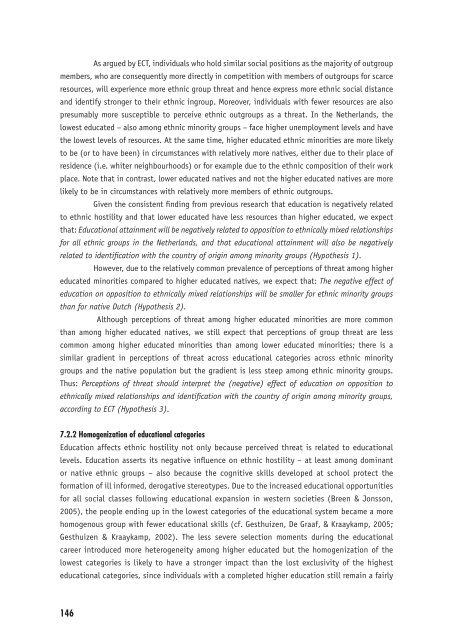Ethnic Hostility among Ethnic Majority and Minority Groups
Ethnic Hostility among Ethnic Majority and Minority Groups
Ethnic Hostility among Ethnic Majority and Minority Groups
Create successful ePaper yourself
Turn your PDF publications into a flip-book with our unique Google optimized e-Paper software.
As argued by ECT, individuals who hold similar social positions as the majority of outgroup<br />
members, who are consequently more directly in competition with members of outgroups for scarce<br />
resources, will experience more ethnic group threat <strong>and</strong> hence express more ethnic social distance<br />
<strong>and</strong> identify stronger to their ethnic ingroup. Moreover, individuals with fewer resources are also<br />
presumably more susceptible to perceive ethnic outgroups as a threat. In the Netherl<strong>and</strong>s, the<br />
lowest educated – also <strong>among</strong> ethnic minority groups – face higher unemployment levels <strong>and</strong> have<br />
the lowest levels of resources. At the same time, higher educated ethnic minorities are more likely<br />
to be (or to have been) in circumstances with relatively more natives, either due to their place of<br />
residence (i.e. whiter neighbourhoods) or for example due to the ethnic composition of their work<br />
place. Note that in contrast, lower educated natives <strong>and</strong> not the higher educated natives are more<br />
likely to be in circumstances with relatively more members of ethnic outgroups.<br />
Given the consistent fi nding from previous research that education is negatively related<br />
to ethnic hostility <strong>and</strong> that lower educated have less resources than higher educated, we expect<br />
that: Educational attainment will be negatively related to opposition to ethnically mixed relationships<br />
for all ethnic groups in the Netherl<strong>and</strong>s, <strong>and</strong> that educational attainment will also be negatively<br />
related to identifi cation with the country of origin <strong>among</strong> minority groups (Hypothesis 1).<br />
However, due to the relatively common prevalence of perceptions of threat <strong>among</strong> higher<br />
educated minorities compared to higher educated natives, we expect that: The negative effect of<br />
education on opposition to ethnically mixed relationships will be smaller for ethnic minority groups<br />
than for native Dutch (Hypothesis 2).<br />
Although perceptions of threat <strong>among</strong> higher educated minorities are more common<br />
than <strong>among</strong> higher educated natives, we still expect that perceptions of group threat are less<br />
common <strong>among</strong> higher educated minorities than <strong>among</strong> lower educated minorities; there is a<br />
similar gradient in perceptions of threat across educational categories across ethnic minority<br />
groups <strong>and</strong> the native population but the gradient is less steep <strong>among</strong> ethnic minority groups.<br />
Thus: Perceptions of threat should interpret the (negative) effect of education on opposition to<br />
ethnically mixed relationships <strong>and</strong> identifi cation with the country of origin <strong>among</strong> minority groups,<br />
according to ECT (Hypothesis 3).<br />
7.2.2 Homogenization of educational categories<br />
Education affects ethnic hostility not only because perceived threat is related to educational<br />
levels. Education asserts its negative infl uence on ethnic hostility – at least <strong>among</strong> dominant<br />
or native ethnic groups – also because the cognitive skills developed at school protect the<br />
formation of ill informed, derogative stereotypes. Due to the increased educational opportunities<br />
for all social classes following educational expansion in western societies (Breen & Jonsson,<br />
2005), the people ending up in the lowest categories of the educational system became a more<br />
homogenous group with fewer educational skills (cf. Gesthuizen, De Graaf, & Kraaykamp, 2005;<br />
Gesthuizen & Kraaykamp, 2002). The less severe selection moments during the educational<br />
career introduced more heterogeneity <strong>among</strong> higher educated but the homogenization of the<br />
lowest categories is likely to have a stronger impact than the lost exclusivity of the highest<br />
educational categories, since individuals with a completed higher education still remain a fairly<br />
146












